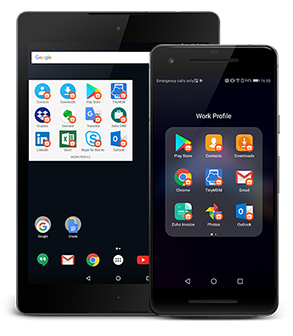What does the BYOD acronym stand for?
BYOD means “Bring Your Own Device”. It is the practice of letting employees use their own smartphones or tablets to access business data. According to a 2021’s Qualtrics study, out of 300 employees, 68% used this working method.

Its advantages for employees and enterprises
The possibility to use their own Android smartphones, enables the collaborators to have better flexibility and better productivity. Indeed, by allowing employees to use their own devices, you avoid the risk of them forgetting to bring the devices with them. You also allow them to get things done more efficiently, since he has chosen his own smartphone and is comfortable with it.
For the enterprise, the Bring our Own Device enables first of all to increase employee responsiveness as smartphone users are now highly connected and can work from everywhere (in transports, at coffee, at home…) and at more flexible hours. In addition, a key point for the company is that the personal smartphone used in a professional context strongly reduces the equipment costs. The employer doesn’t have to provide devices or manage their repair. The only cost for the enterprise is the management software to secure professional data, which is not necessarily expensive when comparing the different existing solutions.
How to secure BYOD?
This management mode is used in many structures, in particular since the health crisis and the significant increase of working from home. As previously explained, the use of a single smartphone to manage the personal and professional life has many benefits for the company and the collaborator. Therefore, using this tool without any restriction nor securisation of the business part could be a real danger for the company’s cybersecurity. Smartphone thefts, data leakage or malwares links to the installed applications are part of the many dangers already existing. Indeed, every year, 70 millions of personal smartphones are lost, and in 8 out of 10 cases, there is an attempt to access data. That is why it is necessary to set up a devices’ policy.
Yet, among the companies that have unmanaged devices, 48% faced a resistance from employees to install a MDM on their personal device. Indeed, at the first glance, collaborators are scared that the company could have access and control the entire device. However, the installation of a MDM, like TinyMDM, on a personal device, means installing one application that will create a container for the business data (business applications, shared files, professional contacts…) in order to separate private and professional life. The MDM manager can remotely delete the work profile in case of device loss or employee departure. From the employee’s point of view, he will only see the company-owned container deleted, but this won’t have any consequences on its personal use. Moreover, in no way the mobile device management solution has access to the settings, installed applications, geolocation nor remote control. All those features are available only for corporate devices provided for a professional use only.

The BYOD mode creates a better flexibility for both parties. It is important to know that even though a company doesn’t set up a MDM system, it has a lot of chances that its collaborators will access professional data (email account, internal secured files…) without telling anyone. For example, in 2020 in France, only 24% of french employees had mobile devices provided for working from home, according to an IPSOS study for SFAM. It means that at the beginning of the crisis and the increase of home working, many were those who worked on their private tablet or smartphone. Without a centralized management software, the possibility of data leakage is bigger, as shown in the Verizon Mobile Security Index 2020, with 40% of enterprises confirmed they faced mobile phones attacks in 2020.
6th of October 2021
